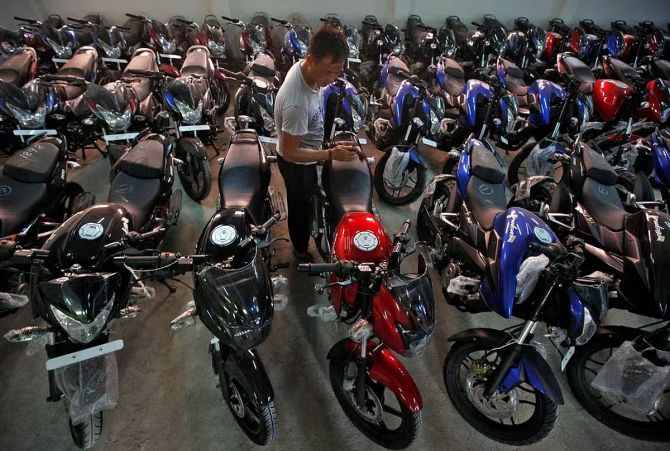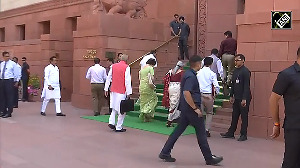Bajaj Auto, the king of the market for CNG-powered passenger three-wheelers, now wants to replicate this dominance in two-wheelers.

The difference is that while the former is zooming — registrations for CNG-powered passenger three-wheelers nearly doubled during January-December 2023 — the latter, meaning a market for CNG-powered two-wheelers, does not exist.
CNG, or compressed natural gas, works in a way similar to petrol in internal combustion engines (ICE), but is considered more environment-friendly and cheaper to run than petrol.
More and more auto-rickshaws find it economical and profitable to run on CNG, pushing up the penetration of CNG in all three-wheelers from 26 per cent in 2020 to 57 per cent now. In passenger three-wheelers, CNG is 67 per cent.
But CNG has not yet been proven as a commercially viable two-wheeler fuel.
In 2016, the central government started a pilot with Indraprastha Gas Ltd to run two-wheelers on CNG in Delhi, under which a few Honda Activa scooters were converted to CNG, but the project did not go far.
Undaunted, Bajaj is looking at launching a CNG-powered motorcycle by 2024-25 and then testing the market with a CNG scooter.
For projections, it is looking at electric two-wheelers as an indication.
“We expect it [CNG two-wheelers] to mirror the share of electric.
"If 5 to 7 per cent of mobikes are expected to go electric, there is no reason not to have a similar share for CNG.
"And in scooters, if that number is 25 per cent for electric, we are looking at the same levels for CNG,” Rakesh Sharma, executive director of Bajaj Auto, told Business Standard.
Driven by 3-wheelers
Bajaj is not the first company in the world to think of CNG for two-wheelers.
Way back in 2009, Zanella, in Argentina, came out with a factory-fitted CNG model, but it did not lead to a big commercial breakthrough.
Some companies in China have tried it, but did not look at scale.
Bajaj draws its confidence from its success with CNG-powered three-wheelers.
Sharma says many who buy ICE three-wheelers and replace it after seven years are now coming after four years to replace their ICE vehicle with a CNG version.
They find it so remunerative they do not mind giving up on the remaining three years of their ICE three-wheeler.
As a positive side effect, the conversion to CNG helps in reducing carbon emissions, one of the stated goals of the government to curb the ill effects of climate change.
In addition to its three-wheeler success, Bajaj is buoyed by the widespread CNG infrastructure that has burgeoned in the last few years,
with 4,600 filling stations in more than 335 towns, as of the last quarter.
A study undertaken by Bajaj shows the average density of CNG stations is one for every 62,000 people.
The network already covers 70 per cent of the two-wheeler market.
Comparing this to the EV infrastructure, EV players say there are almost 10,500 public charging stations in the country, of which 80 per cent are in the metros.
These numbers must be seen in the context of the time taken to recharge an electric two-wheeler (four to seven hours, depending on the battery) versus the three to six minutes spent on refilling a CNG vehicle.
Talking costs
But how does the cost of ownership and operations compare?
Sharma says the running cost per kilometre is more relevant in the case of motorcycles, which typically run 40 to 50 km a day, sometimes more, than for scooters, whose usage is usually 20 to 30 km.
This, says Bajaj, needs a nuanced look.
The cost of running a petrol three-wheeler is about Rs 4.4 per km and of a CNG three-wheeler about ~2.5 per km — 45 per cent lower.
The difference, the company says, would be very similar, if not the same, for two-wheelers.
For electric two-wheelers, however, the running costs are far lower than even CNG.
Sharma says he cannot give out the difference between the cost of producing an electric two-wheeler and a CNG-powered one, because it is competitive information, but CNG two-wheelers would have a lower cost than electric two-wheelers.
In theory, to make
CNG two-wheelers, the company has to modify its ICE platform to make it suitable to run on CNG.
Industry experts say 90 per cent of the cost of producing a CNG two-wheeler could be the same as a petrol two-wheeler.
In electric, on the other hand, the commonality of components is only about 35 per cent.
That said, CNG two-wheelers would need to be priced higher than their petrol versions, not only because of the modifications but also because the ICE market has much larger and more efficient economies of scale.
That is why Bajaj has been trying to persuade the government to lower the goods and services tax on CNG two-wheelers to promote their adoption.
Minuses and pluses
Bajaj Auto’s competitors, especially startups making electric two-wheelers, say Bajaj’s push for CNG does not make sense for them.
“We don’t find any benefit that compensates for the problems, such as the additional weight of the kit leading to less efficiency, and the fears on safety.
"Also, the range of electric, which was a worry earlier, is no longer an issue, as electric two-wheelers can be easily charged at home.
So, frankly, it has no pluses for us,” says the founder of a leading EV startup that once considered CNG.
Others say CNG does not really address the two focus areas of the government on going green.
One is reducing the foreign exchange outgo by cutting down on fossil fuels.
India depends on imports for half of its natural gas needs.
The other is to reduce carbon emissions.
CNG, they say, can be an interim measure at best, as it reduces emissions but to the extent EVs do.
There have also been concerns on safety. Lugging a gas cylinder on a mobike can be tricky.
Bajaj executives point out that there are safety norms clearly written down by the government, and, because so many three-wheelers with CNG cylinders are moving around the country, the fear is unfounded.
The challenge is to design a CNG unit top down again so it is in sync with the vehicle.
That is a work in progress.
Some of Bajaj’s rivals say its CNG drive comes from the motorcycle major’s experience in building an electric motorcycle with power, which would require heavier and bigger batteries.
A heavier and larger battery impinges on performance and efficiency, undermining the appeal of a motorcycle.
It can be done, but the price differential between an electric mobike and its ICE version will be so huge that it will not be a viable market proposition.
CNG could be the answer.












 © 2025
© 2025